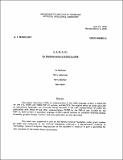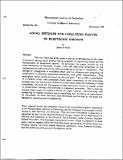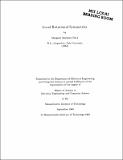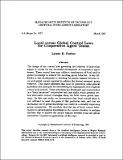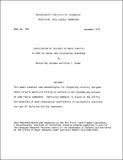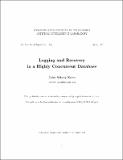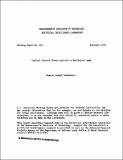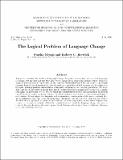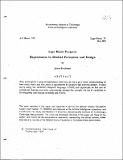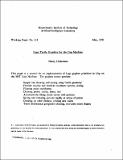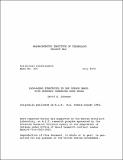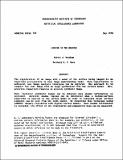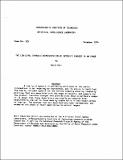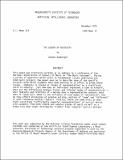Browsing Artificial Intelligence Lab Publications by Title
Now showing items 871-890 of 1835
-
LLOGO: An Implementation of LOGO in LISP
(1975-03-01)This paper describes LLOGO, an implementation of the LOGO language written in MACLISP for the ITS, TEN50 and TENEX PDP-10 systems, and MULTICS. The relative merits of LOGO and LISP as educational languages are discussed. ... -
A Local Front End for Remote Editing
(1982-02-01)The Local Editing Protocol allows a local programmable terminal to execute the most common editing commands on behalf of an extensible text editor on a remote system, thus greatly improving speed of response without ... -
Local Methods for Localizing Faults in Electronic Circuits
(1976-11-01)The work described in this paper is part of an investigation of the issues involved in making expert problem solving programs for engineering design and for maintenance of engineered systems. In particular, the paper ... -
Local Rotational Symmetries
(1985-08-01)This thesis describes a new representation for two-dimensional round regions called Local Rotational Symmetries. Local Rotational Symmetries are intended as a companion to Brady's Smoothed Local Symmetry Representation ... -
Local Versus Global Control Laws for Cooperative Agent Teams
(1992-03-01)The design of the control laws governing the behavior of individual agents is crucial for the successful development of cooperative agent teams. These control laws may utilize a combination of local and/or global ... -
Localization and Positioning Using Combinations of Model Views
(1992-09-01)A method for localization and positioning in an indoor environment is presented. The method is based on representing the scene as a set of 2D views and predicting the appearances of novel views by linear combinations ... -
Localization of Failures in Radio Circuits: A Study in Causal and Teleological Reasoning
(1974-12-01)This paper examines some methodologies for diagnosing correctly designed radio circuits which are failing to perform in the intended way because of some faulty component. Particular emphasis is placed on the utility ... -
Location Recognition Using Stereo Vision
(1989-10-01)A mobile robot must be able to determine its own position in the world. To support truly autonomous navigation, we present a system that builds and maintains its own models of world locations and uses these models to ... -
Lock
(1972-06-01)LOCK is a miscellaneous utility program operating under the ITS system. It allows the user to easily and conveniently perform a variety of infrequently required tasks. Most of these relate to console input-output or the ... -
Logging and Recovery in a Highly Concurrent Database
(1994-06-01)This report addresses the problem of fault tolerance to system failures for database systems that are to run on highly concurrent computers. It assumes that, in general, an application may have a wide distribution in ... -
Logical Control Theory Applied to Mechanical Arms
(MIT Artificial Intelligence Laboratory, 1979-02)A new control algorithm based upon Logical Control Theory is developed for mechanical manipulators. The controller uses discrete tesselations of state space and a finite set of fixed torques to regulate non-rehearsed ... -
The Logical Problem of Language Change
(1995-12-01)This paper considers the problem of language change. Linguists must explain not only how languages are learned but also how and why they have evolved along certain trajectories and not others. While the language ... -
LOGO Manual
(1974-12-01)This document descibes the LOGO system implemented for the PDP 11/45 at the M.I.T. Artificial Intelligence Laboratory. The "system" includes not only the LOGO evaluator, but also a dedicated time-sharing system which ... -
Logo Music Projects: Experiments in Musical Perception and Design
(1979-05-01)This memo gives a series of experiments which one can use to get a better understanding of how music works and how music is apprehended by an active and knowing listener. It does so by using the children's computer ... -
Logo Progress Report 1973-1975
(1975-09-01)Over the past two years, the Logo Project has grown along many dimensions. This document provides an overview in outline form of the main activities and accomplishments of the past as well as the major goals guiding ... -
Logo Turtle Graphics for the Lisp Machine
(MIT Artificial Intelligence Laboratory, 1981-05-05)This paper is a manual for an implementation of Logo graphics primitives in Lisp on the MIT Lisp Machine. The graphics system provides: Simple line drawing and erasing using "turtle geometry" Flexible relative and absolute ... -
Look-Ahead Strategies in One Person Games with Randomly Generated Game Trees
(1970-07-01)A random method for generated binary trees is presented, ad twp forms of a class of one person games called, "Tree Solitaire" which have such trees as their game trees are defined. After what "look ahead strategy" ... -
Looking in the Shadows
(MIT Artificial Intelligence Laboratory, 1976-05)The registration of an image with a model of the surface being imaged is an important prerequisite to many image understanding tasks. Once registration is achieved, new image analysis techniques can be explored. One approach ... -
The Low-level Symbolic Representation of Intensity Changes in an Image
(1974-12-01)A family of symbols is defined by which much of the useful information in an image may be represented, and its choice is justified. The family includes symbols for the various commonly occuring intensity profiles that are ... -
The Luxury of Necessity
(1974-12-01)This paper was originally written as an address to a conference of the National Association of Schools of Music on "The Music Consumer". Posing a series of questions which point to fundamental issues underlyin the ...

